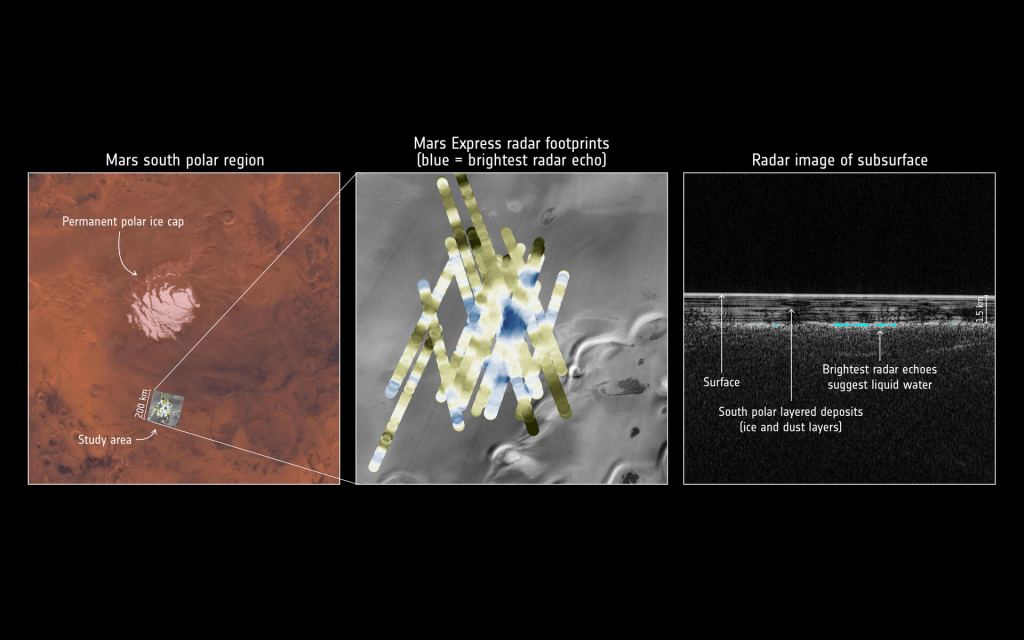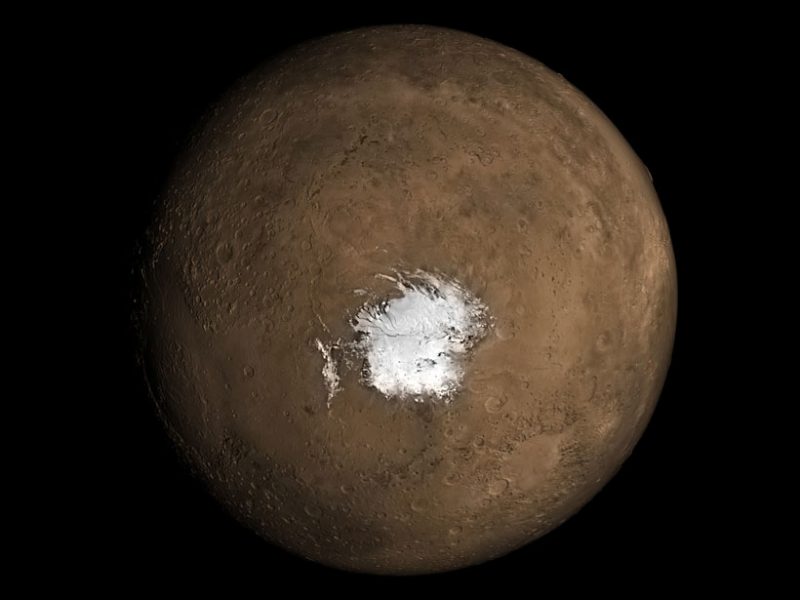There’s no surface water on Mars now, but there was a long time ago. If you ask most people interested in Mars, what’s left of it is underground and probably frozen.
But some previous evidence shows there’s a lake of liquid water under the planet’s South Pole Layered Deposits (SPLD). Other evidence refutes it. So what’s going on?
Science, that’s what.
Is there a lake under Mars’ southern polar cap? Two new studies released concurrently tackled the question, and each one arrived at a different answer. One confirms the liquid lake; another refutes it. What are people to make of this?
It might look like scientists don’t know what they’re doing, but the opposite is true. This back-and-forth is the scientific method playing out in real-time.
We’re accustomed to simple yes or no answers, but that’s not how things are. We all know that the Earth is round, right? But it wasn’t always this way. Everyone had the same evidence, but it took a lot of discussions and arguing before people established that the Earth is a sphere. And even that isn’t exactly correct: Earth is an oblate spheroid.
Things aren’t always straightforward, and nature hides the truth.
“I’d really like to know if brines do or do not exist under the SPLD, but uncertainty rules the day!”
Dr. David Stillman, Geophysicist, Southwest Research Institute.
The question around Mars’ underground lakes is vexing because we can’t go there and look. We have to rely on orbiters with remote sensing to gather evidence. And that data has to be interpreted. The interpretation is where it gets tricky.
In 2018, radar data from the ESA’s Mars Express spacecraft hinted at an underground lake below the ice near Mars’ south pole. A team of Italian researchers reported the discovery in the journal Science. Data showed a 20 km (12.5 miles) long reflective subsurface zone, and the scientists concluded that it was water, or more accurately, brines.

The purported lake is buried about 1.5 km below the surface, and it’s briny, which makes it resist freezing. It’s analogous to lakes found in northern Canada, and NASA previously found the necessary salts on Mars that could keep the lake from freezing. So there were reasons to believe the findings were plausible.
The discovery prompted some skepticism. Jeffrey Plaut, a planetary scientist at NASA’s Jet Propulsion Laboratory, said, “It’s not quite a slam dunk yet.” There were calls for more supporting evidence.
Then in 2020, another study confirmed the presence of the lake—and found additional lakes. Or what they interpreted to be lakes. They were more buried reflective surfaces. This study generated more excitement, not just because there were lakes, but because they, or something like them on Mars, might support simple life.
Then a 2021 study showed that the reflective surfaces could be clays. The scientific back and forth was in full swing. Where does the issue sit now?
Two new studies released only days apart come to separate conclusions. Will one of them bring this issue to a satisfactory end?
A new research letter published in the journal Earth and Planetary Science Letters says that the original 2018 discovery of liquid water under Mars’ south pole could still be correct. Its title is “Assessing the role of clay and salts on the origin of MARSIS basal bright reflections.” The first author is Elisabetta Mattei from the Department of Mathematics and Physics at Roma Tre University. Mattei and co-authors were also authors of the original 2018 paper showing the presence of liquid water under Mars’ southern polar region. This letter is a scientific response to other published findings against their initial discovery of a subsurface lake.
The issue boils down to the reflectivity detected by an instrument on the Mars Express orbiter. The device is MARSIS (Mars Advanced Radar for Subsurface and Ionosphere Sounding.) It measures the subsurface composition of Mars and searches for frozen water. In a nutshell, liquid water and frozen water return different signals; liquid water is more reflective than frozen water.

MARSIS data is the basis of the 2018 paper announcing the presence of buried liquid water. It’s also the basis for the papers that arrive at different explanations for the measured reflectivity. The data isn’t in doubt, just the interpretations and other scientific inquiry around the data.
The research concluding that there is no liquid water says that other things cause the reflectivity.
Nathaniel Putzig is a senior scientist with the Planetary Science Institute. Putzig is one of the authors of a paper presenting other explanations for the reflectivity in MARSIS data. In a press release, Putzig said, “It is not necessary to invoke liquid water at the base of the polar cap to explain the results of the MARSIS observations. Alternatives include clays, some metallic minerals, and salty ice.”
But the new research letter doesn’t agree. The authors acknowledge the counter-explanations for the MARSIS signal, but they offer counter-counter-explanations. They discount clays, metallic minerals and salty ice as explanations. “Combining previous published data, simulations, and new laboratory measurements, we demonstrate that the dielectric properties of these materials do not generate strong basal reflections at MARSIS frequencies and Martian temperatures,” they write. “Only brines can generate such high dielectric contrast at low basal temperature,” they add.
The new research letter favouring water is partly based on lab experiments done by a scientist at the Southwest Research Institute (SwRI.) Geophysicist David Stillman, a co-author of the new research letter, conducted laboratory experiments on ice-brine mixtures at low temperatures.
“Lakes of liquid water actually exist beneath glaciers in Arctic and Antarctic regions, so we have Earth analogs for finding liquid water below the ice,” said Stillman, a specialist in detecting water in any format — liquid, ice or absorbed — on planetary bodies. “The exotic salts that we know exist on Mars have amazing ‘antifreeze’ properties allowing brines to remain liquid down to -103 degrees Fahrenheit. We studied these salts in our lab to understand how they would respond to radar.”
“The research showed that we don’t have to have lakes of perchlorate and chloride brines, but that these brines could exist between the grains of ice or sediments and are enough to exhibit a strong dielectric response. This is similar to how seawater saturates grains of sand at the shoreline or how flavouring permeates a slushie but at -103 degrees Fahrenheit below a mile of ice near the South Pole of Mars,” Stillman said.
Temperature is a critical factor in this issue. We don’t know what the temperature is one-and-a-half kilometres below the Martian surface. It’s too low for liquid water, but it can remain liquid at lower temperatures if the water is briny. The temperature also affects the permittivity of different materials and the data that MARSIS gathers.

The paper is a detailed examination of the different types of clays on Mars and how they appear different in MARSIS data at different temperatures. “Temperature has a dominating effect on the dielectric properties of clay and clay sediments,” the authors write. “The drastic effect of temperature on the dielectric behaviour of clays is confirmed by our set of measurements conducted on clay sediments at different water content, clay content, and different mineralogy. Very low temperatures, such as those commonly inferred at the base of the SPLD (~200 K), are totally inconsistent with the hypothesis that clay sediments can generate a dielectric contrast with the SPLD large enough to obtain bright basal echoes.”
“Our dielectric measurements on Mg(ClO4)2 and CaCl2 brines at Martian subglacial conditions rule out also salty ice as the cause for MARSIS bright reflections,” they write in their paper’s conclusion.
In some of the lab experiments, Dr. Stillman subjected clay samples to extremely low temperatures. “For example, the 100 mM Mg(ClO4)2 (magnesium perchlorate) sample was held at 193 K for 72 hours and never fully froze, until the temperature was reduced to 188 K,” the paper says.
Dr. Stillman talked about the temperature problem with Universe Today.
“The temperature behind the SPLD is critical. Our understanding of this temperature is poor,” Stillman said. “The <Sori and Bramson> paper we reference is a lower bound assumption assuming the SPLD is a single piece of nearly pure ice. It is likely not a single sheet of ice, but much more complex.”
Scientists also don’t know how conductive the SPLD is, which affects temperature uncertainty.

So are there lakes below Mars’ south pole? We don’t know yet. If there is something there, it might be more slush than a lake, and it might not be anything like buried lakes on Earth.
This back-and-forth shows the power of the scientific method. Nobody’s saying the data’s wrong; they’re just engaging with the evidence and reaching different conclusions.
“This is how the scientific method works. It is frustrating to see papers that came out within a week of each other coming to vastly different conclusions,” Stillman said. (Dr. Stillman refers to a paper led by Cyril Grima, a planetary scientist at the University of Texas Institute for Geophysics. Universe Today will cover that paper in a separate article.)
COVID plays a role, too. In more normal times, scientists would discuss issues like this at conferences and share ideas and lines of inquiry. While face-to-face discussions at conferences don’t guarantee consensus, they are a part of the scientific process.
“I think some of this is because of the much lower interaction of scientific groups due to the lack of in-person conferences due to COVID,” Stillman said. “This is also occurring because different science groups make different assumptions,” Stillman said, referring to estimates of the underground temperature.
“Honestly, I do not know which assumptions are correct because we are studying a planet so far away with very limited data.”
This discussion will continue for a while, and we need better data before there is widespread agreement. It’s frustrating for researchers and the rest of us interested in Mars, water, habitability, and the host of issues that ride shotgun alongside Martian water.
But it’s also a fascinating look at the scientific method playing out as intended.
“I’d really like to know if brines do or do not exist below the SPLD, but uncertainty rules the day! I still think partially saturated brines are the most correct answer, but I cannot be positive,” Stillman said. “I look forward to debating this in the literature and at in-person conferences. I mean, this is what makes science fun!”

